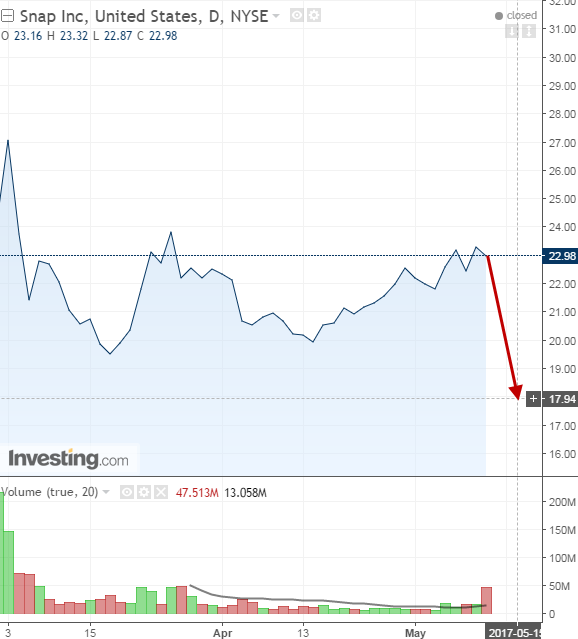by Clement Thibault

Snap Inc. (NYSE:SNAP), parent company of the popular visual communication app Snapchat, reported earnings yesterday after the US market close. The company was expected to report a loss of $0.22 per share on $158 million in revenue. The company strongly disappointed: it reported an EPS of minus $0.2, on $149 million in revenue. Shares fell 23% in after hours trading to $17.68. For perspective, Snap's all-time high was $29.44, reached the day after company's March 2nd IPO.
Prior to the initial public offering, we raised a flag about four major risks to keep an eye on. Now wiser about Snap by one quarterly report and its associated management conference call, let's see if anything changed.
Growth
Everyone wants to see strong growth from young companies, especially user and revenue growth, since actual earnings are often out of the question in the shorter-term future. Unfortunately, Snapchat's user growth slowed drastically during the past two, pre-IPO quarters. Naturally, investors were particularly eager to see if Snap could turn things around in this report.
When we wrote our earlier piece, we estimated that over 180 million DAUs (Daily Active Users) would be considered a success, while anything under 170 million would be considered a failure. This was our primary concern.
Yesterday the company reported only 166 million DAUs for the quarter. This is not a temporary issue; this could become a catalyst for the potential collapse of the company going forward. It might be obvious, but it needs to be said: there's no platform without users. And if the user base starts shrinking how can a social media company survive?
Evan Spiegel, Snap's CEO, tried to use the company's failure to use 'growth hacking' methods such as push notifications to explain away the slowing growth. He also said the company thinks about DAU growth "as a derivative of the growth in creation". Unfortunately, all this isn't very clear, but that matters little. When your company has a market cap of $27 billion but there no profitability in sight, you'd better figure out a way to provide accelerated growth in other areas.
Competition from Facebook's (NASDAQ:FB) Instagram, which basically copied Snapchat features, was our second concern. During the conference call, Spiegel admitted that "people are going to copy your products if you make great stuff", and that "you've got to get comfortable with" that. This is true for all products that have few barriers to entry because they lack such safeguards as patent protection or groundbreaking, proprietary technology. Spiegel's comments are, frankly a bald admission that, well, everything about Snapchat is extremely vulnerable to replication by competitors.
Spiegel also added:
"When Google (NASDAQ:GOOGL) came along, everyone really felt like they needed a search strategy. When Facebook came along, everyone felt they needed a social strategy. And now I think with Snap, with our company, we believe that everyone is going to develop a camera strategy".
Snap may see itself as a camera company, but the rest of the world views it as not much more than a social media company that's relying on advertising for revenue. Exactly like Facebook.
That's it. Right now there is just not enough value-add in Snapchat to offer any differentiation. With Facebook now emphasizing original augmented reality features as its next pathway to growth, Snapchat might not just be open to being copied, it might also quickly be eclipsed.
Management
Our third concern was the inexperience of Snap's management which was painfully apparent during the conference call. Spiegel was more interested in expounding about creativity rather than addressing tangible results. Of course, that may be because right now there's not much to talk about regarding Snap's results.
And though investors in early stage companies might be happy to hear about creativity, once you're traded on Wall Street, it's all about the business. Experienced CEOs usually have some sort of ace-in-the-hole they can use to drive the conversation if tangible results are few and the report was notably bad. In such cases they'll focus on the business's positives and potential. Spiegel obviously wasn't savvy enough to be prepared with any serious talking points, completely misreading what investors actually care about. It will be interesting to see if the company is able to adapt to the realities of being public traded in the coming quarter.
IPO volatility
Finally, we said the company's first year would likely be a bumpy ride, whether results were good or not. Shares going down 23% in after-hours trading bears that out. That's the nature of an IPO – at first every newly public company is tough to valuate, tough to model. It takes up to a year before share prices stabilize and the Street has a less harsh reaction to earnings and corporate news. As such, we expect more big moves in the coming months.
Conclusion
Our advice when Snap went public—to either short the stock at its peak or stay away—proved correct. The company is now down 26% from its IPO opening price of $24. We questioned the company's valuation at $27 billion when it first went public, and we continue to do so even at its lower market cap of $20 billion.
The company has few prospects for growth, its competitive environment is unfavorable, and management doesn’t appear ready to lead a publicly traded company. There's absolutely nothing right now to justify Snap's current price.
